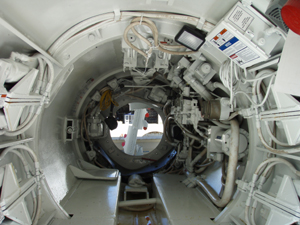Pipe Jacking in Michigan
May 1, 2008
 The City of Lansing, Mich.’s, Combined Sewer Overflow Control Program is part of the “Cleaner, Greener Lansing Initiative” that began in 1992 and will continue through 2020.
The City of Lansing, Mich.’s, Combined Sewer Overflow Control Program is part of the “Cleaner, Greener Lansing Initiative” that began in 1992 and will continue through 2020. Lowe Construction, Horton, Mich., was involved in several phases of this program, recently completed work during the Phase IV, Segment Four Downtown project consisting of 1,600 ft of pipe jacking in four drives, two jacking and three receiving shafts. The contractor used an Akkerman tunnel boring machine (TBM) WM54SC and 5000 series jacking system. The general contractor for this phase of the project was Kamminga & Roodvoets Inc., Grand Rapids, Mich. The design and construction engineer were Tetra Tech and Capital Consultants, both of Lansing, Mich.
This project presented many challenges and the mandatory timeline to complete the work did not allow any margin for error. A subsequent dewatering process put the project on hold for six weeks. A concurrent steam line replacement project took place just 20 ft above the pipe jacking project. The steam line created heightened temperatures for the crew working on the tunnel, ranging around 100 steamy degrees.
Temperature and sloppy soil conditions made the environment less than desirable. The TBM had to maintain a strict line and grade, which was difficult in the layered soil conditions. Additionally, the shaft location at Washington Avenue and Kalamazoo Street was on Cooley Law School’s only dorm on campus so the pressure was on to not have displaced students. All these components combined created a demanding situation for crewmembers.
The total scope of work was to pipe jack 1,600 ft of 20-ft lengths of 54-in. steel casing pipe in four drives from two jacking shafts and three receiving shafts. The steel casing pipe housed a ductile iron carrier pipe that was installed along a pre-fabricated rail system on the base of the steel casing. The annular space between the steel and iron pipe was filled with grout. The central launch shaft was 33 ft deep and located at the intersection of Washington Avenue and Kalamazoo Street. This shaft was shored with the use of Protec’s slide rail system.
In mid-May 2007, Lowe Construction launched the TBM WM54SC from the jacking pit to the west of this intersection. The contractor had difficulty keeping the machine on line and grade due to very wet, split-faced soil. Upon completing 75 lf of the 400-ft drive, Lowe encountered unanticipated high groundwater levels, which swamped and seized the TBM in place. The crew was forced to cease pipe jacking while dewatering wells were installed and given time to dewater. This delayed the project for six weeks. Lowe Construction began again shortly after July 4 and were able to complete the first 400-ft drive at the required .87 percent grade.
The next drive was due east of the shaft from Washington Avenue to Grand Avenue at a negative .74 percent grade. After this drive, a new jacking shaft was constructed at the intersection of Kalamazoo Street and Grand Avenue. A drive due south on Grand Avenue from Kalamazoo Street to Lenawee Street went 480 ft at .45 percent grade. The final drive was from Kalamazoo Street to Washtenaw Street for 400 ft at .32 percent grade. All of the drives were fairly complex given the varied soil consisting of layers of silty clay and granular material containing many cobbles and boulders. This required the crew to frequently interchange the cutter faces on the TBM to maintain the pipeline heading.
Akkerman’s TBM WM54SC and 5000 Series Pipe Jacking System represents Akkerman Inc.’s flagship product, which put Akkerman on the map 35 years ago. Unique to Akkerman, the TBM cutter faces and parts can be replaced in the tunnel, eliminating lost production time.
The TBM is thrust forward by a yoke and the hydraulic force of the 5000 pump unit along the skid. As the TBM advances forward, the cutter face breaks up the soil and the granular material falls in the inner drum and is deposited onto the conveyor belt where it is transported to the haul system. As the TBM advances, the pipe string is advanced behind it by the jacking frame. Small track is laid down at the bottom of the pipe string, which acts as a rail system for the dirt bucket and haul unit to transport soil out of the tunnel. A standard TBM package includes dirt cutter, carbide cutter and sand shelves that easily interchange and are suitable for removing specific types of soil. Akkerman Wheel Machines cut the tunnel three quarters of an inch larger to create an annular space to fill with a bentonite solution to ease jacking trust.
This high-profile job was subjected to scrutiny since the City of Lansing is the state’s capital and construction had a large influence on the local economy. Lowe’s adherence to a rigorous schedule was imperative since there were additional projects that were contingent on the completion of this phase of the project. Lowe Construction and Kamminga & Roodvoets had to complete and pave the pipe jacking work before the asphalt plants closed for the winter.
Fortunately, the was job was completed in early October. The schedule was met and officials with the City of Lansing were pleased with the results.
City director of public services Chad Gamble said, “The accuracy record of the TBM that is spec’d for installing new utilities is very important because of the web of existing utilities in the infrastructure. We’ve found Akkerman’s TBM to be very precise, which in turn allows for construction to progress in a timely fashion. Accuracy translates into cost-savings for businesses and residents in the downtown area.”
Laura Anderson is a marketing specialist at Akkerman Inc., which is based in Brownsdale, Minn.
